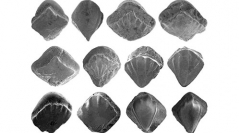

 Geodiversitas
27 (3) - Pages 349-380
Geodiversitas
27 (3) - Pages 349-380Silurian acanthodian associations from western Lithuanian deep shelf graptolite facies and eastern Lithuanian shallow shelf and lagoonal carbonate facies are described and biozonation (Interval range zones) based on stratigraphic ranges of 45 taxa deduced. The Wenlock Series is characterized by the species-poor Arenaceacanthus arcuatacanalis-Gomphonchus? Minutus Acanthodian Zone in east Lithuania, whereas in west Lithuania both of these zonal species occur later, in the Ludfordian (Ludlow). The Nostolepis gracilis and Rohonilepis breviornatus acanthodian zones occur at the end of the Ludlow in these two areas. The Fecundosquama basiglobosa Acanthodian Zone is distinguished in the formations of the Upper Minija Regional Stage (Pridoli) and has a wider regional distribution (discovered also in Latvia, Estonia and former East Prussia). The latest Pridolian Jūra Formation is subdivided into four acanthodian zones (from lowest to highest), the Nostolepis alta, Cheiracanthoides planus, Vesperalia perplexa and Endemolepis inconstans zones, and its eastern correlative the Lapės Formation into three, the Monospina erecta, Cheiracanthoides planus and Endemolepis inconstans zones. The acanthodian associations are the most abundant microvertebrates and are distinguished by the dominance of Nostolepis-derived taxa.
Silurian, Wenlock, Ludlow, Pridoli, acanthodian microremains, faunal associations, biostratigraphic zones, Lithuania